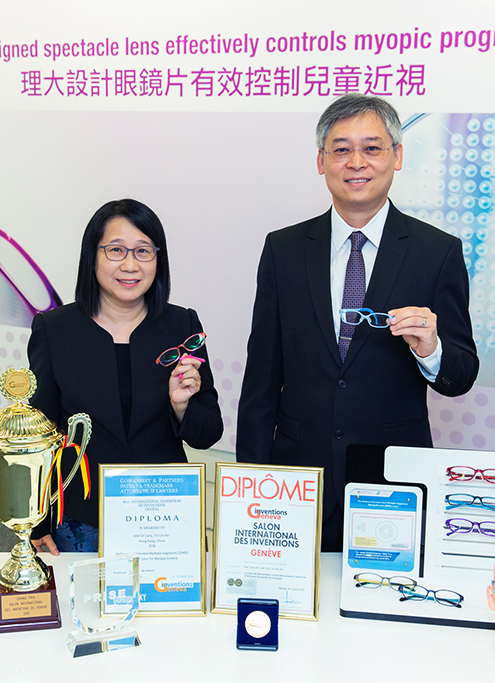Deep myopia causes life challenges for many individuals and even increases the risk of other types of eye diseases. In recent years, a Hong Kong research team has successfully developed a new non-invasive solution in the form of an invention, which can slow down myopia progression in children. It has even reversed the myopia in some individuals. This internationally award-winning invention is a piece of welcome news for short-sighted children!
The research team led by Professor Carly Lam, Professor of the School of Optometry at The Hong Kong Polytechnic University (PolyU), and Professor To Chi-ho, Chair Professor of Experimental Optometry, Henry G. Leong Professor in Elderly Vision Health and Head of the School, developed the Defocus Incorporated Multiple Segments (DIMS) spectacle lens, which incorporated myopic defocus into a conventional visual correction lens. The DIMS lenses effectively slowed down myopia progression by 60% while more than 20% of the short-sighted children that participated in the clinical trial did not have any myopia progression.
The DIMS lens won the Grand Prize (overall championship), a Grand Award and a Gold Medal receiving the Congratulations of the Jury at the 46th International Exhibition of Inventions in Geneva, Switzerland in 2018 and the 2020 SILMO d’Or Award (Vision) in the prestigious SILMO optical fair in France.
Before introducing the DIMS lens, let’s learn about its journey!

(From left to right) Professor Carly Lam, Professor of the School of Optometry and Professor To Chi-ho, Chair Professor of Experimental Optometry, Henry G. Leong Professor in Elderly Vision Health
Reducing myopia progression at a young age can significantly reduce the chance of suffering severe visual impairment and blindness due to high myopia in later life. Myopia control is currently possible through optical or pharmaceutical approaches.
This optical approach – being less invasive – is preferable. Research and innovation is changing clinical practice in myopia control for children and will, in the long run, reduce the burden of visual health cost both at an individual level and at a societal level.
Twenty years ago, the cause of myopia was a matter of controversy and the ability of managing it in a clinical manner was a hit or a miss. Through the team’s efforts, they validated and proved their hypothesis on the visual modulation of eye growth. This research has achieved a breakthrough and will make an impact in different ways.
Click on the keywords below to learn more!
Professor Lam and Professor To’s research team is the first group in the world that has the record of testing their hypothesis across avian (birds) animals, mammals and then to humans within a clinical trial setting.
The DIMS lens is now commercially available in more than 10 countries and regions, including Hong Kong, China, Singapore, Malaysia, Canada, France, Australia, United Kingdom, Italy and Russia etc.
The team proposed principle of adopting simultaneous vision correction and myopic defocus for myopia control is now widely accepted by peers in the field of myopia research. Their work has extended collaboration to over 25 research institutions. Their translational lenses received high regards from clinicians fitting the lenses and has influenced clinical practice with evidence-based research.
Over 3,000 seminars in Hong Kong, the Mainland and other countries have been organized, attracting more than 75,000 practitioners to attend workshops, seminars and talks since the launch of the DIMS Lens in 2018. The team foresaw significant demand from Asian countries, including Singapore, Malaysia and Korea.
Around 1,280,000 pieces of DIMS Lens have been sold in the first 36 months since its launch in July 2018
As the eyeball develops rapidly from early childhood to adolescence, progression of myopia is the fastest during this period. This is also a key period for myopia treatment. Compared with using atropine or orthokeratology, the DIMS lens is a non-invasive intervention and hence there is no age limitation and can even benefit young children.
The team anticipates that many children will no longer suffer from high myopia and will not suffer from visual impairment or blindness cause by high myopia growing up. In such scenarios, their risk of suffering from other eye diseases and the economic burden caused by the illness will also be reduced benefiting their whole life.
The epidemic of myopia in the ageing myopic population will impose an excessive burden on the overburndened public healthcare systems. Numerous types of costs are associated with its impact including the cost of myopia corrections, public ophthalmologic services, training extra optometrists and ophthalmologists, the social welfare cost for caring the vision impaired, cost of accidents such as falls due to visual impairment as well as loss of productivity due to vision impairment. Prevention of high myopia, in turn, will reduce the number of people suffering from myopia-related vision impairments and therefore alleviate the burden on the public healthcare system.
© 2025 University Grants Committee Secretariat. All rights reserved